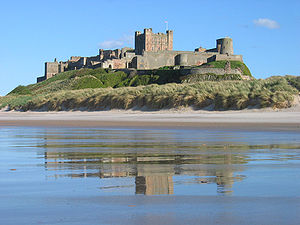Until the 19th century, Blackpool was just a small hamlet. It rose to prominence with the building of the railway linking it to the mill towns of industrial Lancashire and Yorkshire and soon became England's most popular holiday resort, with its miles of golden sands. The unique Blackpool Illuminations were first switched on in 1879 to extend the season well into the autumn

A view from the top of the tower, looking down on two of the three piers
These photograph were taken in early April - hence the quiet beaches.
Sometimes people have the misguide impression of the north east of England as one of empty shipyards and mining communities. But the Northumberland Coast is beautiful - as here in a peaceful scene of the beach by Bamburgh Castle (below).
 M
MAs a child I remember having a book on heroines in history with an illustration of Grace Darling (1815-1842), the lighthouse keeper's daughter at Bamburgh, who in 1838 risked storms and icy seas to rescue sailors from the shipwrecked "Forfarshire". She died of consumption just four years later and is buried in Bamburgh, with a museum dedicated to her life.

The view on a fine day from the castle ramparts over to the Farne Islands.
Also on the English north east coast is South Shields, in County Durham - my husband's birthplace.

Robin Hood's Bay in North Yorkshire is a picturesque old fishing village. The origin of its name is obscure as it is long way from Nottingham, traditionally the home of the legendary Robin Hood. The village, with its steep narrow streets leading down to the sea, was known as a smuggler's haunt in the 18th century.
Head north now to Scotland.

The wide sweep of the beach at North Berwick, 20 miles south of Edinburgh in East Lothian. Taken on a quiet June day.

Canty Bay, near North Berwick. In the distance in the middle of the Firth of Forth, is the prominent Bass Rock, an island with its lighthouse and seabird colonies. an island in he middle of the the Firth of Forth, On the right is the prominent Bass Rock with its lighthouse and seabird colonies. An early Christian hermit is said to have settled here. A castle was later built there which in the 17th century was used to house prisoners - an isolated, windy, inhospitable, exposed spot with little chance of escape.

Castle Sands at St. Andrew's, Fife. St Andrew's Castle, built around 1200, was the official residence of Scotland’s leading bishop (and later archbishop) throughout the Middle Ages. Its size signalled the power and wealth of these important churchmen. The fortress repeatedly exchanged hands between the Scots and the English in several battles but St Andrews Castle suffered significant damage during the Wars of Independence with England (1296–1356). It was left without a resident or a purpose when bishops were abolished in 1592. It fell rapidly into ruin.
Across to the other side of the country:

Rockcliffe Bay on the Solway coast of south west Scotland was our destination for a short break on the trail of my husband's ancestors.
And finally to the Isle of Iona off the west coast of Scotland.

A beautiful, peaceful beach to ourselves amidst the wonderful scenery on the Isle of Iona, looking across to the Isle of Mull in the Scottish West Highlands.


Not the razz-ma-tazz seaside of my opening ditty -
but beautiful beaches that stay in my memory.
Copyright © 2022 · Susan Donaldson. All Rights Reserved







Wonderful scenes, and glad you have memories as well as knowing the history.
ReplyDelete